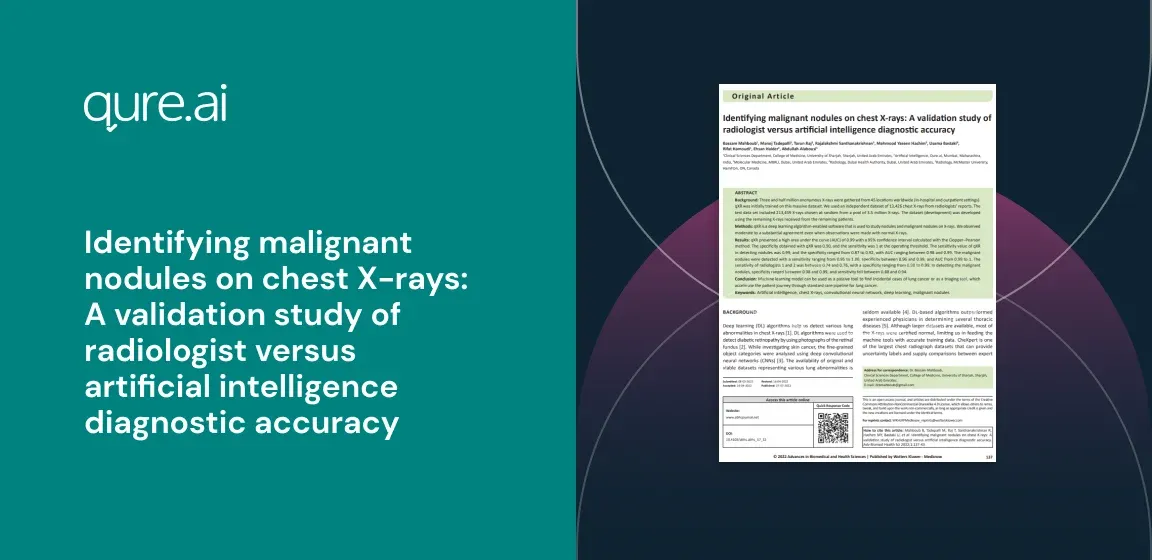Background:
Published 12 Aug 2022
Identifying malignant nodules on chest X-rays: A validation study of radiologist versus artificial intelligence diagnostic accuracy
Author: Bassam Mahboub1, Manoj Tadepalli 2,Tarun Raj 2, Rajalakshmi Santhanakrishnan 2,Mahmood Yaseen Hachim 3, Usama Bastaki 4 ,Rifat Hamoudi 1,Ehsan Haide5,Abdullah Alabousi 51

Back
Three and half million anonymous X-rays were gathered from 45 locations worldwide (in-hospital and outpatient settings). qXR was initially trained on this massive dataset. We used an independent dataset of 13,426 chest X-rays from radiologists’ reports. The test data set included 213,459 X-rays chosen at random from a pool of 3.5 million X-rays. The dataset (development) was developed using the remaining X-rays received from the remaining patients.
Methods
qXR is a deep learning algorithm-enabled software that is used to study nodules and malignant nodules on X-rays. We observed moderate to a substantial agreement even when observations were made with normal X-rays.
Results
qXR presented a high area under the curve (AUC) of 0.99 with a 95% confidence interval calculated with the Clopper–Pearson method. The specificity obtained with qXR was 0.90, and the sensitivity was 1 at the operating threshold. The sensitivity value of qXR in detecting nodules was 0.99, and the specificity ranged from 0.87 to 0.92, with AUC ranging between 0.98 and 0.99. The malignant nodules were detected with a sensitivity ranging from 0.95 to 1.00, specificity between 0.96 and 0.99, and AUC from 0.99 to 1. The sensitivity of radiologists 1 and 2 was between 0.74 and 0.76, with a specificity ranging from 0.98 to 0.99. In detecting the malignant nodules, specificity ranged between 0.98 and 0.99, and sensitivity fell between 0.88 and 0.94.
Conclusion
Machine learning model can be used as a passive tool to find incidental cases of lung cancer or as a triaging tool, which accelerate the patient journey through standard care pipeline for lung cancer
Authors
Bassam Mahboub1, Manoj Tadepalli 2,Tarun Raj 2, Rajalakshmi Santhanakrishnan 2,Mahmood Yaseen Hachim 3, Usama Bastaki 4 ,Rifat Hamoudi 1,Ehsan Haide5,Abdullah Alabousi 51
Citation
1. Clinical Sciences Department; College of Medicine;University of Sharjah; Sharjah-United Arab Emirates 2. Artificial Intelligence; Qure.ai; Mumbai; Maharashtra-India 3. Molecular Medicine; MBRU; Dubai-United Arab Emirates 4. Radiology; Dubai Health Authority; Dubai-United Arab Emirates 5. Radiology; McMaster University; Hamilton; ON-Canada